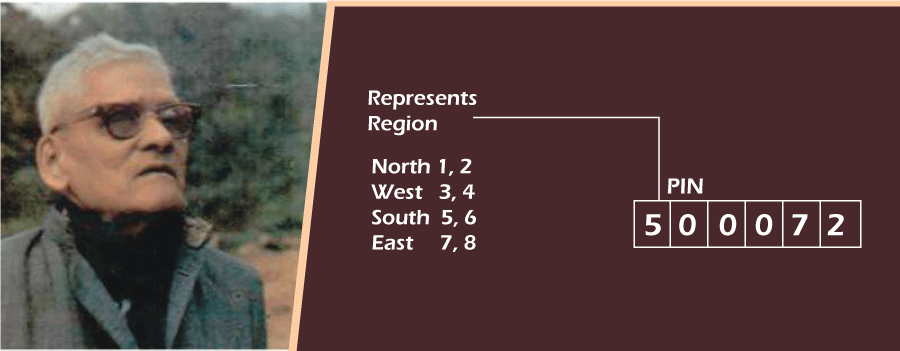What is the full form of PIN CodePIN Code: Postal Index Number CodePIN stands for Postal Index Number. Shri Bhikaji Velankar created it to make the postal service simple. Indian PIN codes have now reached their silver jubilee as the country celebrates its 75th year of independence. Learn fascinating information about the India Postal Index Number system by reading. 
For the majority of India, Egypt, Sumer, Rome, Greece, and China, letters have been the most traditional form of communication. However, have you ever wondered how these confession letters reach their final destination? Well, the allocated Pin Code will give the right response. With the 75th anniversary of India's independence, the Postal Index Number established by Shriram Bhikaji Velankar became 50. On August 15, 1972, the PIN code for the Postal Service was made available in India. Across the nation, couriers, letters, and other postal products are sent using the six-digit code. Read the entire article to learn the What, When, Where, Why, and How of the unique six-digit postal code. Describe Pincode:The PIN Code's full name is Postal Index Number. It was first used by the Indian postal service to separate the regions on August 15, 1972. Each of the six numbers in the region's postal code has a specific meaning. Shriram Bhikaji Velankar was responsible for introducing the PinCode system to India. The senior member of the Posts and Telegraph Boards and assistant secretary in the Union Ministry of Communications was the Sanskrit expert Velankar. Postal Index Number (PIN):India Post uses a six-digit method for numbering post offices called the Postal Index Number. Different postal index numbers, or codes, have been issued to each city and its areas. It helps quickly sort letters according to a certain location in all of India's cities. Postal Index Number Arrangement:Digit 1: The area is indicated by the first digit of the PIN code. India is separated into nine regions using the Postal Index Number Code. Digit 2: The second digit designates the sub-region, such as Maharashtra, Gujarat, Haryana, Madhya Pradesh, etc. Digit 3: The third digit identifies the region's sorting district. Digits 4 to 6: Within a district, certain post offices are given the digits 4 to 6. For example, Jabalpur's PIN code, 482001, is within this range because Madhya Pradesh is in the area with PIN codes that begin with 45-48. Why was the Pin Code Necessary?The largest postal network in the world is one of the largest in countries, including India. There are around 1.5 lakh post offices in the entire nation. Owing to similar names in several places or due to language limitations, the process of sorting and distributing letters could have been clearer. Therefore, established the pin code method to simplify the procedure. The country was divided into nine geographical regions and distributed the pin codes under those divisions. And the Army Postal Service alone received one point out of them. 19101 pins in all have been distributed around the nation, according to the postal department. What's the Process Behind the Postal Index Number?There are a total of 6 digits in the postal index number. All the digits are valid throughout the nation and represent various types of information. The first digit indicates the postal region, which might be East, West, North, or South. The second digit represents the sub-region, while the third region symbolizes the sorting district. The remaining figures better define the geographic area and indicate the post office's location. These packages, letters, items, and pin codes are afterward transported to the post office or courier services based on Pincode segregation. All of these are then forwarded from here to the destination address. Who was Responsible for Pincode?
The Sanskrit scholar and poet Shri Ram Bhikaji first introduced Postal Index Numbers. He developed the concept of using Pincode to better identify letters and couriers in the nation. He saw the urgent need for a system to increase the effectiveness of the Indian Postal System while working as a senior member of the Telegraph Board and as an additional secretary in the Ministry of Communication. Through pin codes, Bhikaji developed such a reliable network that it became advantageous to ship goods anywhere in the nation.
The Conclusion:Postal Index Number, a PIN code, is a six-digit numeric number used in the Indian postal system by India Post and is typically found at the end of every complete address in India. This information will help in your knowledge of PIN codes. Questions that are often askedFind out the most frequently asked questions about PIN Code. Question 1: What exactly is a PIN code? Answer: It is a 6-digit code that helps better segregation in the Indian postal system. Question 2: What does PIN's full name mean? Answer: PIN stands for Postal Index Numbers in their full form. Question 3: Who is credited with creating the Indian postal code system? Answer: The Indian Postal Code System was first introduced by Shriram Bhikaji Velankar. Question 4: When was India's PIN Code system implemented? Answer: On August 15, 1972, the PIN was first introduced in India.
Next TopicFull Form Lists
|
 For Videos Join Our Youtube Channel: Join Now
For Videos Join Our Youtube Channel: Join Now
Feedback
- Send your Feedback to [email protected]
Help Others, Please Share










